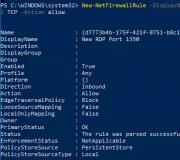Laboratory work 9 study of an electric motor. We understand the principles of operation of electric motors: the advantages and disadvantages of different types
To use presentation previews, create a Google account and log in to it: https://accounts.google.com
Slide captions:
In the pictures, determine the direction of the Ampere force, the direction of the current in the conductor, the direction of the magnetic field lines, and the poles of the magnet. N S F = 0 Let's remember.
Laboratory work No. 11 Study of a DC electric motor (on a model). Purpose of the work: to get acquainted with a model of a DC electric motor with its structure and operation. Equipment and materials: electric motor model, laboratory power supply, key, connecting wires.
Safety regulations. There should be no foreign objects on the table. Attention! Electricity! The insulation of the conductors must not be damaged. Do not turn on the circuit without the teacher's permission. Do not touch the rotating parts of the electric motor with your hands. Long hair must be removed so that it does not get caught in the rotating parts of the engine. After completing the work, put the workplace in order, open the circuit and disassemble it.
The order of work. 1. Consider the model of the electric motor. Indicate its main parts in Figure 1. 1 2 3 Fig.1 4 5 1 - ______________________________ 2 - ______________________________ 3 - ______________________________ 4 - ______________________________ 5 - ______________________________
2. Assemble an electrical circuit consisting of a current source, an electric motor model, a key, connecting everything in series. Draw a diagram of the circuit.
3. Rotate the motor. If the engine does not work, find the reasons and eliminate them. 4. Change the direction of current in the circuit. Observe the rotation of the moving part of the electric motor. 5.Draw a conclusion.
Literature: 1. Physics. 8th grade: studies. for general education institutions/A.V. Peryshkin. - 4th ed., finalized. - M.: Bustard, 2008. 2 . Physics. 8th grade: studies. For general education institutions / N.S. Purysheva, N.E. Vazheevskaya. - 2nd ed., stereotype. - M.: Bustard, 2008. 3. Laboratory work and test assignments in physics: Notebook for 8th grade students. - Saratov: Lyceum, 2009. 4. Notebook for laboratory work. Sarahman I.D. Municipal educational institution secondary school No. 8 in Mozdoka, North Ossetia-Alania. 5. Laboratory work at school and at home: mechanics / V.F. Shilov.-M.: Education, 2007. 6. Collection of problems in physics. Grades 7-9: a manual for general education students. institutions / V.I. Lukashik, E.V. Ivanova.-24th ed.-M.: Education, 2010.
Preview:
Laboratory work No. 11
(on model)
Goal of the work
Devices and materials
Progress.
Laboratory work No. 11
Studying DC Electric Motor
(on model)
Goal of the work : get acquainted with a model of a DC electric motor with its structure and operation.
Devices and materials: electric motor model, laboratory power supply, key, connecting wires.
Safety regulations.
There should be no foreign objects on the table. Attention! Electricity! The insulation of the conductors must not be damaged. Do not turn on the circuit without the teacher's permission. Do not touch the rotating parts of the electric motor with your hands.
Practice tasks and questions
1.What physical phenomenon is the action of an electric motor based on?
2.What are the advantages of electric motors over thermal ones?
3. Where are DC electric motors used?
Progress.
1. Consider the model of the electric motor. Indicate its main parts in Figure 1.
2. Assemble an electrical circuit consisting of a current source, an electric motor model, a key, connecting everything in series. Draw a diagram of the circuit.
Fig.1
Draw a conclusion.
3. Rotate the motor. If the engine does not work, find the reasons and eliminate them.
4. Change the direction of current in the circuit. Observe the rotation of the moving part of the electric motor.
Fig.1
Electric motors are devices in which electrical energy is converted into mechanical energy. The principle of their operation is based on the phenomenon of electromagnetic induction.
However, the way the magnetic fields interact, causing the motor rotor to rotate, differ significantly depending on the type of supply voltage - alternating or direct.
The principle of operation of a DC electric motor is based on the effect of repulsion of like poles of permanent magnets and attraction of unlike poles. The priority of its invention belongs to the Russian engineer B. S. Jacobi. The first industrial model of a DC motor was created in 1838. Since then, its design has not undergone fundamental changes.
In low-power DC motors, one of the magnets is physically existing. It is attached directly to the machine body. The second is created in the armature winding after connecting a direct current source to it. For this purpose, a special device is used - a commutator-brush unit. The collector itself is a conductive ring attached to the motor shaft. The ends of the armature winding are connected to it.
In order for torque to occur, the poles of the permanent magnet of the armature must be continuously swapped. This should happen at the moment the pole crosses the so-called magnetic neutral. Structurally, this problem is solved by dividing the collector ring into sectors separated by dielectric plates. The ends of the armature windings are connected to them alternately.
To connect the collector to the power supply, so-called brushes are used - graphite rods with high electrical conductivity and a low coefficient of sliding friction.The armature windings are not connected to the supply network, but are connected to the starting rheostat through a commutator-brush assembly. The process of turning on such a motor consists of connecting to the supply network and gradually reducing the active resistance in the armature circuit to zero. The electric motor turns on smoothly and without overload.
Features of using asynchronous motors in a single-phase circuit
 Despite the fact that the rotating magnetic field of the stator is easiest to obtain from a three-phase voltage, the operating principle of an asynchronous electric motor allows it to operate from a single-phase household network if some changes are made to their design.
Despite the fact that the rotating magnetic field of the stator is easiest to obtain from a three-phase voltage, the operating principle of an asynchronous electric motor allows it to operate from a single-phase household network if some changes are made to their design.
To do this, the stator must have two windings, one of which is the “starting” winding. The current in it is shifted in phase by 90° due to the inclusion of a reactive load in the circuit. Most often for this
Almost complete synchronism of magnetic fields allows the engine to gain speed even with significant loads on the shaft, which is what is required for the operation of drills, rotary hammers, vacuum cleaners, grinders or floor polishers.
If an adjustable one is included in the supply circuit of such an engine, then its rotation frequency can be smoothly changed. But the direction, when powered from an alternating current circuit, can never be changed.
Such electric motors are capable of developing very high speeds, are compact and have greater torque. However, the presence of a commutator-brush assembly reduces their service life - graphite brushes wear out quite quickly at high speeds, especially if the commutator has mechanical damage.Electric motors have the highest efficiency (more than 80%) of all devices created by man. Their invention at the end of the 19th century can be considered a qualitative leap in civilization, because without them it is impossible to imagine the life of a modern society based on high technology, and something more effective has not yet been invented.
Synchronous principle of operation of an electric motor on video
Laboratory works→ number 10
Study of a DC electric motor (on a model).
Goal of the work: Familiarize yourself with the basic parts of a DC electric motor using a model of this motor.
This is perhaps the easiest work for the 8th grade course. You just need to connect the motor model to a current source, see how it works, and remember the names of the main parts of the electric motor (armature, inductor, brushes, semi-rings, winding, shaft).
The electric motor offered to you by your teacher may be similar to the one shown in the figure, or it may have a different appearance, since there are many options for school electric motors. This is not of fundamental importance, since the teacher will probably tell you in detail and show you how to handle the model.
Let us list the main reasons why a properly connected electric motor does not work. Open circuit, lack of contact of brushes with half rings, damage to the armature winding. If in the first two cases you are quite capable of handling it on your own, if the winding breaks, you need to contact a teacher. Before turning on the engine, you should make sure that its armature can rotate freely and nothing interferes with it, otherwise when turned on, the electric motor will emit a characteristic hum, but will not rotate.
current"Place of the lesson in the work program: lesson 55, one of the lessons on the topic “Electromagnetic phenomena”.
The purpose of the lesson: Explain the structure and principle of operation of an electric motor.
Tasks:
study the electric motor using a practical method - performing laboratory work.
learn to apply acquired knowledge in non-standard situations to solve problems;
To develop students’ thinking, continue to practice the mental operations of analysis, comparison and synthesis.
continue to develop students’ cognitive interest.
Methodological goal: the use of health-saving technologies in physics lessons.
Forms of work and types of activities in the lesson: testing knowledge, taking into account the individual characteristics of students; laboratory work is carried out in micro groups (pairs), updating students’ knowledge in a playful way; explanation of new material in the form of a conversation with a demonstration experiment, goal setting and reflection.
During the classes
1)Checking homework.
Independent work (multi-level) is carried out during the first 7 minutes of the lesson.
Level 1.
Level 2.
Level 3.
2). Learning new material. (15 minutes).
The teacher announces the topic of the lesson, the students formulate a goal.
Updating knowledge. Game of "yes" and "no"
The teacher reads the phrase; if the students agree with the statement, they stand up; if not, they sit.
The magnetic field is generated by permanent magnets or electric current.
There are no magnetic charges in nature.
The south pole of the magnetic needle indicates the south geographic pole of the Earth.
An electromagnet is a coil with an iron core inside.
The magnetic field lines are directed from left to right.
The lines along which magnetic arrows are installed in a magnetic field are called magnetic lines.
Presentation plan.
The effect of a magnetic field on a current-carrying conductor.
The dependence of the direction of movement of the conductor on the direction of the current in it and on the location of the poles of the magnet.
The design and operation of a simple commutator electric motor.
Movement of a conductor and frame with current in a magnetic field.
Design and principle of operation of a DC electric motor.
Safety briefing.
The work is carried out according to the description in the textbook p. 176.
4.The final stage of the lesson.
Task. Two electron beams repel, and two parallel wires carrying current in the same direction attract. Why? Is it possible to create conditions under which these conductors will also repel?
Reflection.
What new did you learn? Is this knowledge needed in everyday life?
Questions:
What determines the speed of rotation of the rotor in an electric motor?
What is an electric motor?
P . 61, create a crossword puzzle on the topic “electromagnetic phenomena.
Application.
Level 1.
1. How do opposite and like poles of magnets interact?
2. Is it possible to cut a magnet so that one of the resulting magnets has only a north pole, and the other has only a south pole?
Level 2.
Why is the compass body made of copper, aluminum, plastic and other materials, but not iron?
Why do steel rails and strips lying in a warehouse become magnetized after some time?
Level 3.
1.Draw the magnetic field of a horseshoe magnet and indicate the direction of the field lines.
2. Two pins are attracted to the south pole of the magnet. Why do their free ends repel each other?
Level 1.
1. How do opposite and like poles of magnets interact?
2. Is it possible to cut a magnet so that one of the resulting magnets has only a north pole, and the other has only a south pole?
Level 2.
Why is the compass body made of copper, aluminum, plastic and other materials, but not iron?
Why do steel rails and strips lying in a warehouse become magnetized after some time?
Level 3.
1.Draw the magnetic field of a horseshoe magnet and indicate the direction of the field lines.
2. Two pins are attracted to the south pole of the magnet. Why do their free ends repel each other?
MKOU "Allakskaya Secondary School"
Open physics lesson in 8th grade on the topic “ The effect of a magnetic field on a current-carrying conductor. Electrical engine. Laboratory work No. 9 “Study of an electric DC motor current."
Prepared and conducted by: first category teacher Elizaveta Aleksandrovna Taranushenko.
1. Purpose of the work: Study the starting features, mechanical characteristics and methods of regulating the rotation speed of a DC motor with mixed excitation.
Adaniye.
2.1. to independent work:
Study the design features, switching circuits of DC motors;
Study the method of obtaining the mechanical characteristics of a DC motor;
Familiarize yourself with the features of starting and regulating the rotation speed of a DC motor;
Draw circuit diagrams for measuring the resistance of the armature circuit and field windings (Fig. 6.4) and testing the motor (Fig. 6.2);
Using fig. 6.2 and 6.3 draw up an installation diagram;
Draw the forms of tables 6.1... 6.4;
Prepare oral answers to test questions.
2.2. to work in the laboratory:
Familiarize yourself with the laboratory setup;
Record in table 6.1. engine nameplate data;
Measure the resistance of the armature circuit and field windings. Record the data in table 6.1;
Assemble the circuit and conduct a study of the engine, write down the data in tables 6.2, 6.3, 6.4;
Construct a natural mechanical characteristic n=f(M) and speed characteristics n=f(I B) and n=f(U);
Draw conclusions based on the research results.
General information.
DC motors, unlike AC motors (primarily asynchronous), have a higher starting torque ratio and overload capacity, and provide smooth control of the rotation speed of the working machine. Therefore, they are used to drive machines and mechanisms with difficult starting conditions (for example, as starters in internal combustion engines), as well as when it is necessary to regulate the rotation speed within large limits (feed mechanisms of machine tools, running-brake stands, electrified vehicles).
Structurally, the engine consists of a stationary unit (inductor) and a rotating unit (armature). The field windings are located on the magnetic core of the inductor. There are two of them in a mixed-excitation motor: parallel with terminals Ш 1 and Ш2 and serial with terminals C1 and C2 (Fig. 6.2). The resistance of the parallel winding R ovsh is, depending on the engine power, from several tens to hundreds of Ohms. It is made of small cross-section wire with a large number of turns. The series winding has a low resistance R obc (usually from several Ohms to fractions of an Ohm), because consists of a small number of turns of large cross-section wire. The inductor is used to create a magnetic excitation flux when its windings are supplied with direct current.
The armature winding is placed in the grooves of the magnetic circuit and brought to the collector. Using brushes, its terminals I and I 2 are connected to a direct current source. The armature winding resistance R I is small (Ohms or fractions of an Ohm).
The torque M of a DC motor is created by the interaction of the armature current Iya with the magnetic excitation flux F:
М=К × Iя × Ф, (6.1)
where K is a constant coefficient depending on the engine design.
When the armature rotates, its winding crosses the excitation magnetic flux and an emf E is induced in it, proportional to the rotation frequency n:
E = C × n × Ф, (6.2)
where C is a constant coefficient depending on the engine design.
Armature circuit current:
I I =(U–E)/(R I +R OBC)=(U–С×n ×Ф)/(R I +R OBC), (6.3)
Solving expressions 6.1 and 6.3 together with respect to n, we find an analytical expression for the mechanical characteristics of the engine n=F(M). Its graphical representation is shown in Figure 6.1.
Rice. 6.1. Mechanical characteristics of a mixed-excitation DC motor
Point A corresponds to engine idling at rotation speed n o. With increasing mechanical load, the rotation speed decreases and the torque increases, reaching the nominal value M H at point B. In the aircraft section, the engine is overloaded. The current Iya exceeds the rated value, which leads to rapid heating of the armature and OVS windings, and sparking on the collector increases. The maximum torque Mmax (point C) is limited by the operating conditions of the collector and the mechanical strength of the engine.
Continuing the mechanical characteristic until it intersects the torque axis at point D, we would obtain the value of the starting torque when the motor is directly connected to the network. The emf E is zero and the current in the armature circuit, in accordance with formula 6.3, increases sharply.
To reduce the starting current, a starting rheostat Rx (Fig. 6.2) with resistance is connected in series to the armature circuit:
Rx = U H / (1.3...2.5) ×I Ya.N. - (R I - R obc), (6.4)
where U h is the rated network voltage;
I Y.N. - rated armature current.
Reducing the armature current to (1.3...2.5)×I Ya.N. provides sufficient initial starting torque MP (point D). As the engine accelerates, resistance Rx is reduced to zero, maintaining an approximately constant value of MP (section SD).
Rheostat R B in the circuit of the parallel excitation winding (Fig. 6.2) allows you to regulate the magnitude of the magnetic flux Ф (formula 6.1). Before starting the engine, it is completely withdrawn to obtain the required starting torque at a minimum armature current.
Using formula 6.3, we determine the engine speed
n = (U - I I (R I + R obc + Rx)) / (С Ф), (6.5)
in which R I, R obc and C are constant quantities, and U, I I and Ф can be changed. This gives rise to three possible ways to regulate engine speed:
Changing the value of the supplied voltage;
By changing the value of the armature current using the adjusting rheostat Rx, which, unlike the starting rheostat, is designed for continuous operation;
By changing the magnitude of the excitation magnetic flux F, which is proportional to the current in the windings OVSh and OVS. In a parallel winding, it can be adjusted with a rheostat R b. Resistance R b is taken depending on the required speed control limits R B = (2...5) R obsh.
The motor nameplate indicates the rated rotation speed, which corresponds to the rated power on the motor shaft at the rated mains voltage and the output resistances of the rheostats R X and R B.



